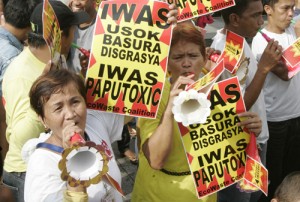Government agencies and health advocates ramped up the campaign against the use of firecrackers on Thursday, five days before the start of New Year revelry.
Waste and pollution watchdog EcoWaste Coalition, the Department of Health (DOH), Philippine National Police (PNP), Bureau of Fire Protection (BFP) and Manila’s First District Rep. Benjamin Asilo organized a multi-stakeholder campaign called “Pamayanang Hindi Nagpapaputok: Buo, Busog at Malusog.”
Holding giant mock firecrackers with the poison sign and the word “Danger,” the groups paraded in barangays in Tondo, Manila, to promote the use of safe and eco-friendly noisemakers.
“Firecrackers are the last thing anyone needs to celebrate the season, especially since these have already been proven to be harmful to humans, animals and the environment,” said Aileen Lucero, national coordinator of the EcoWaste Coalition.
“The money saved by not blowing up firecrackers and fireworks can aid ongoing humanitarian efforts in places ravaged by Super Typhoon Yolanda,” Lucero said.
“By shunning firecrackers and pyrotechnics, our communities and families will come out unscathed from the New Year’s revelry,” she added.
Asilo discouraged people from lighting firecrackers, which he said can cause “unwarranted injuries, fire, and large-scale pollution.”
“I urge the public to shun firecrackers, greet the New Year with their fingers and eyes unharmed, and with the surroundings clear of toxic smoke and garbage,” he said.
The activity is part of the EcoWaste Coalition’s “Iwas PapuToxic” drive that complements the DOH and other agencies’ own no-to-firecracker campaigns.
Meanwhile, the Makati City government has not lifted the fireworks ban in barangays Bangkal, Magallanes, and Pio del Pilar, which were affected when oil seeped from West Tower Condominium in 2010.
“Although the cleaning phase of the oil leak has been ongoing for years now, the city government deems it proper to keep the ordinance in effect so that no further harm could befall our constituents,” Makati Mayor Jejomar Erwin Binay said.
Under City Ordinance 2010-A-020, violators of the firecrackers ban face a fine of P5,000 or six months imprisonment. For partnerships and corporations, the president or general manager shall be held liable.
Banned fireworks include baby rocket, bawang, small triangulo, el Diablo, watusi, and sky rocket.
Binay reminded the public of the 1994 ordinance banning the sale of firecracker to minors. Violation would mean a fine of P1,000 or imprisonment of 15 days.
Reports from the DOH showed that most firecracker-related injuries from December 21, 2012 to January 5 this year involved children aged five to 12.
Manila had 168 recorded incidents, the highest in the National Capital Region.


